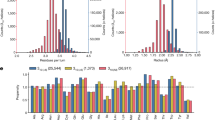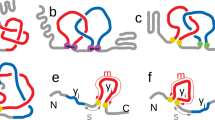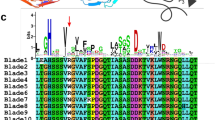Abstract
The sequences of α-helical coiled-coils and bundles are characterized by a specific pattern of hydrophobic and hydrophilic residues which is repeated every seven residues. Highly conserved breaks in this pattern frequently occur in segments of otherwise continuous heptad substructures. The hairpin bend of the ROP protein coincides with such a break and provides a model system for the study of the structural effects induced by heptad discontinuities. The structure of a ROP mutant which re-establishes a continuous heptad pattern, shows insignificant changes relative to the wild-type protein, as is also reflected in its conformational stability, spectroscopic properties and unfolding behaviour. Thus, formation of α-α-hairpin bends may occur both in the presence and absence of heptad breaks.
This is a preview of subscription content, access via your institution
Access options
Subscribe to this journal
Receive 12 print issues and online access
$189.00 per year
only $15.75 per issue
Buy this article
- Purchase on Springer Link
- Instant access to full article PDF
Prices may be subject to local taxes which are calculated during checkout
Similar content being viewed by others
References
DeGrado, W.F., Wasserman, Z.R. & Lear, J.D. Protein design, a minimalist approach. Science 243, 622–628 (1989).
Cohen, C. & Parry, D.A.D. α-Helical coiled coils and bundles: How to design an α-helical protein. Proteins Struct. Funct. Genet. 7, 1–15 (1990).
Hecht, M., Richardson, J.S., Richardson, D.C. & Ogden, R.C. De novo design, expression, and characterization of Felix: A four-helix bundle protein of native-like sequence. Science 249, 884–891 (1990).
Morii, H., Ichimura, K. & Uedaira, H. Asymmetric inclusion by the Novo designed proteins: Fluorescence probe studies on amphiphilic α-helix bundles. Prot. Struct. Funct. Genet. 11, 133–141 (1991).
Kamtekar, S., Sciffer, J.M., Xiong, H., Babik, J. & Hecht, M.H. Protein design by binary patterning of polar and nonpolar amino acids. Science 262, 1680–1685 (1993).
Paliakasis, C.D. & Kokkinidis, M. Relationships between sequence and structure for the four-α-helix bundle tertiary motif in proteins. Prot. Engng. 5, 739–748 (1992).
Chou, K.C., Maggiora, G.M., Scheraga, H.A. Role of loop-helix interactions in stabilizing four-helix bundle proteins. Proc. natn. Acad. Sci. U.S.A., 89, 7315–7319 (1992).
Steif, C., et al. Subunit interactions provide a significant contribution to the stability of the dimeric four-α-helical-bundle protein Rop. Biochemistry 32, 3867–3876 (1993).
Crick, F.H.C. The packing of α-helices: Simple coiled coils. Acta crystallogr. 6, 689–697 (1953).
Lupas, A., Van Dyke, M. & Stock, J. Predicting coiled coils from protein sequences. Science 252, 1162–1164 (1991).
Cohen, C. & Parry, D.A.D. α-helical coiled coils- A widespread motif in proteins. Trends biochem. Sci. 11, 245–248 (1986).
Banner, D.W., Kokkinidis, M. & Tsernoglou, D. Structure of the ColE1 Rop protein at 1.7 Å resolution. J. molec. Biol. 196, 657–675 (1987).
Chou, K.C. The role of loops in stabilizing bundle motif protein structures. Prot. Engng., 4, 849–850 (1991).
Paliakasis, C.D. & Kokkinidis, M. The stability of the four-α-helix bundle motif in proteins. Prot. Engng. 4, 849–850 (1991).
Brunet, A.P. et al. The role of turns in the structure of an α-helical protein. Nature, 364, 355–358 (1993).
Castagnoli, L., Vetriani, C. & Cesareni, G. Linking an easily detectable phenotype to the folding of a common structural motif. Selection of rare turn mutations that prevent the folding of Rop. J. molec. Biol. 237, 378–387 (1994).
Presnell, S.R. & Cohen, F.E. Topological distribution of four-α-helix bundles. Proc. natn. Acad. Sci. U.S.A., 86, 6592–6596 (1989).
Baker, E.N. & Hubbard, R.E. Hydrogen bonding in globular proteins. Prog. Biophys. molec. Biol. 44, 97–179 (1984).
Janin, J., Wodak, S., Levitt, M. & Maigret, B. Conformation of amino acid side-chains in proteins. J. molec. Biol. 125, 357–386 (1978).
Robson, B. & Garnier, J. Introduction to proteins and protein engineering. (Elsevier Science publishers B.V. Amsterdam; 1986).
Thornton, J.M. et al. Analysis of errors found in protein structure coordinates in the Brookhaven Data Bank. Proceedings of the CCP4 Study Weekend, 26-27 January 1990, 39–52, (1990).
Efimov, A.V. Structure of α-α-hairpins with short connections. Prot. Engng. 4, 245–250 (1991).
Smith, W.W., Burnett, R.M., Darling, G.D. & Ludwig, M.L. Structure of the semiquinone form of flavodoxin from clostridium MP. Extension of 1.8 Å resolution and some comparisons with the oxidized state. J. molec. Biol. 117 195–225 (1977).
Reid, L.S. & Thornton, J.M. Rebuilding flavodoxin from Cα coordinates: a test study. Prot. Struct. Funct. Genet. 5, 170–182 (1989).
Richardson, J.S. & Richardson, D.C. Amino acid preferencies for specific locations at the ends of α-helices. Science 240, 1648–1652 (1988).
Serrano, L., Sancho, J., Hirchberg, M. & Fersht, A.R. α-Helix stability in proteins. I. Empirical correlations concerning substitution of side-chains at the N and C-caps and the replacement of Alanine by Glycine or Serine at solvent exposed surfaces. J molec. Biol. 227, 544–559 (1992).
Arutyunyan, E.G., Kuranova, I.P., Vainshtein, B.K. & Steigemann, W. X-ray structure investigation of leghemoglobin. VI. structure of acetate-ferrileghemoglobin at a resolution of 2.0 Å. Kristallografiya, 25, 80–91 (1980).
Ploegman, J.H., Drenth, G., Kalk, K.H. & Hol, W.G.J. Structure of bovine liver rhodanese. I. Structure determination of 2.5 Å resolution and a comparison of the conformation and sequence of its two domains. J. molec. Biol. 123, 557–594 (1978).
Wetlaufer, D. Prolyl isomerization: how significant for in vivo protein folding? Biopolymers 24, 251–255 (1985).
Castagnoli, L. et al. Genetic and structural analysis of the ColE1 Rop (Rom) protein. EMBO J. 8, 621–629 (1989).
Chang, C.T., Wu, C.-S.C. & Yang, J.T. Circular dichroic analysis of protein conformation: Inclusion of the β-turns. Anal. Biochem. 91, 13–31 (1978).
Parry, D.A.D. & Fraser, R.D.B. Intermediate filament structure: 1. Analysis of IF protein sequence data. Int. J. biol. Macromol., 7, 203–213 (1985).
Quax-Jeuken, Y.E.F.M., Quax, W.J. & Bloemendal, H. Primary and secondary structure of hamster vimentin predicted from the nucleotide sequence. Proc. natn. Acad. Sci. U.S.A. 80, 3548–3552 (1983).
McLachlan, A.D. & Karn, J. Periodic features in the amino acid sequence of nematode myosin rod. J. molec. Biol. 164, 605–626 (1983).
CCP4. The SERC (UK) Collaborative Computing Project No.4: A Suite of programmes for protein Crystallography, (distributed from Daresbury Laboratory, Warrington WA44AD, UK; 1979).
Lim, V.I. Algorithms for prediction of α-helical and β-structural regions in globular proteins. J. molec. Biol. 88, 873–894 (1974).
DeGrado, W.F. & Lear, J.D. Induction of peptide conformation of apolar/water interfaces. 1. A study with model peptides of designed hydrophobic periodicity. J. Am. chem. Soc. 107, 7684–7689 (1985).
Lovejoy, B. et al. Crystal structure of a synthetic triple-stranded α-helical bundle. Science 259, 1288–1293 (1993).
Tronrud, D.E., Ten Eyck, L.F. & Matthews, B.W. An efficient general-purpose least-squares refinement program for macromolecular structures. Acta crystallogr. A43, 489–501 (1987).
Kokkinidis,M. et al. Correlation between protein stability and crystal properties of designed Rop variants. Prot. Struct. Funct. .Genet., 16 214–216 (1993).
Matthews, B.W. Solvent content of protein crystals. J. molec. Biol. 33, 491–497 (1968).
Brünger, A.T. X-PLOR Manual, v. 2.1, (Yale University, New Haven, U.S.A.; 1990).
Brünger, A.T. Extension of molecular replacement: a new search strategy based on Patterson correlation refinement. Acta crystallogr. A46, 46–57 (1990).
Read, R.J. Improved Fourier coefficients for map using phases from partial structures with errors. Acta crystallogr. A42, 140–149 (1986).
Jones, T.A. in FRODO: A graphics fitting program for macromolecule in computational crystallography. ed. Sayre, D. 303–317 (Clarendon press, Oxford; (1988).
Brünger, A.T., Krukowski, A. & Erickson, J. Slow-cooling protocols for crystallographic refinement by simulated annealing. Acta crystallogr. A46, 585–593 (1990).
Perkins, S.J. Protein volumes and hydration effects-The calculation of partial specific volumes, neutron scattering matchpoints and 280 nm Absorption coefficients for proteins and glycoproteins from amino acid sequences. Eur. J. Biochem. 157, 3867–3876 (1993).
Privalov, P.L., Plotnikov, V.V. & Filimonov, V.V. Precision scanning microcalorimeter for the study of liquids. J. chem. Thermodynamics 7, 41–47 (1975).
Marky, L.A. & Breslauer, K.J. Calculating thermodynamic data for transitions of any molecularity from equilibrium melting curves. Biopolymers 26, 1601–1620 (1987).
Yang, J.T., Wu, C.-S.C. & Martinez, H.M. Calculation of protein conformation from circular dichroism. Meth. Enzymol. 130, 208–269 (1986).
Author information
Authors and Affiliations
Rights and permissions
About this article
Cite this article
Vlassi, M., Steif, C., Weber, P. et al. Restored heptad pattern continuity does not alter the folding of a four-α-helix bundle. Nat Struct Mol Biol 1, 706–716 (1994). https://doi.org/10.1038/nsb1094-706
Received:
Accepted:
Issue Date:
DOI: https://doi.org/10.1038/nsb1094-706
This article is cited by
-
Segmentation strategy of de novo designed four-helical bundles expands protein oligomerization modalities for cell regulation
Nature Communications (2023)
-
In vitro evolution of thermodynamically stable turns
Nature Structural Biology (1996)
-
Amino-acid substitutions in a surface turn modulate protein stability
Nature Structural Biology (1996)



